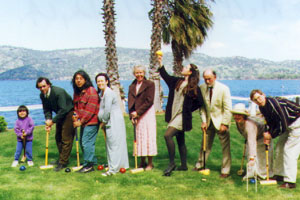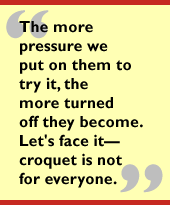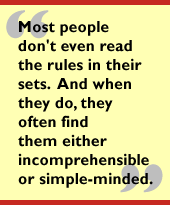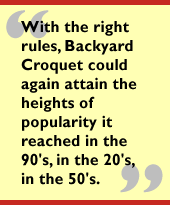
|
Back to |
| The Front Page |
| The Game |
|
Can the orphaned child of our sport – Backyard Croquet – be rehabilitated?
by Bob Kroeger and Bob Alman Posted July 27, 1997 |
|
||||||
Backyard Croquet as a bridge to the Sport
Should organized croquet attempt to regulate and guide the development of "backyard croquet", or should we instead simply confer our blessings upon a multitude of rules and styles cherished by the hundreds of thousands of people who play the toy-scaled game that devolved from the sport a hundred years ago? "Yes" and "Yes", say two organizers and teachers from opposite parts of the country and contrasting perceptions of the game
by Bob Kroeger
Ask ten randomly chosen people on the street (or road) in any neighborhood if they have ever heard of croquet and the vast majority will answer "Yes." Ask them their impression of the game and the answers will range from memories of footing their opponent's ball into the bushes to barbeques at grandma's. Ask them if they ever took the game seriously and the answer will be a resounding "No!"

|
| Traditional backyard croquet is a family affair, as epitomized by three generations of mallet-wielding McGhee's on their own rough turf near Clearlake, California. |
I contend that if the game was taken to the public in an organized manner, we would find many more thousands nationwide who would become interested. I have over the past three years run organized nine-wicket tournaments in the city parks of Cambridge, Massachusetts. What I found was that there are many curious passers-by who go out of their way to sign a mailing list for more information on croquet. I then use that mailing list to invite them to play in my next tournament. I have over 70 people on my list in just three events.
 My proposal to those USCA players who wish to see our numbers grow: run
informal weekend croquet outings with the familiar nine-wicket layout in city
parks. You can also have a six-wicket layout to show the differences between
the two versions. It is best to use Forster Challenge sets or something
similar because of the ease in putting in the wickets. Also bring your own
tournament mallet and one tournament wicket - again for contrast. Have
printed information (from the national association) that can be provided to
pedestrians along with the ever-important mailing list for them to sign.
After a few outings, you will have enough to invite to a weekend
nine-wicket tournament (using nine-wicket rules from the USCA rule book or
the USCA website). Don't force six-wicket croquet on them! Let them play
the version they are familiar with.
My proposal to those USCA players who wish to see our numbers grow: run
informal weekend croquet outings with the familiar nine-wicket layout in city
parks. You can also have a six-wicket layout to show the differences between
the two versions. It is best to use Forster Challenge sets or something
similar because of the ease in putting in the wickets. Also bring your own
tournament mallet and one tournament wicket - again for contrast. Have
printed information (from the national association) that can be provided to
pedestrians along with the ever-important mailing list for them to sign.
After a few outings, you will have enough to invite to a weekend
nine-wicket tournament (using nine-wicket rules from the USCA rule book or
the USCA website). Don't force six-wicket croquet on them! Let them play
the version they are familiar with.
Before the event ends (assuming there are two relatively experienced six-wicket players in the event), demonstrate a 20-minute version of the six-wicket game including break play with narration by one or both of the players. Breaks are unheard of to untrained nine-wicket players. Once they see the different croquet shots and the patterns established in breaks, there will be a new-found respect for a version of the game they never knew existed.
For those skeptical readers who are saying, "But you can't run breaks in a city park" - YOU'RE WRONG! In fact, delayed triple peels can be accomplished. Yes, the courts have to be undersized, you will have to experiment and find the smoothest surface available, but it can be done - especially if you widen the wickets appropriately to compensate for the rough turf.
Anyone who would like to be personally guided through this process is invited to E-mail me. I am passionate about promoting the sport to everyone who is interested.
While I do love to play on bentgrass and bermudagrass, my roots are in the backyard game and there is a lot of pleasure to be derived from playing it. My friend Reid Flemming - arguably the most successful six-wicket American rules player in North America - agrees with me.
E-mail: Bobkroeger@aol.com
Give them rules that fit the traditional backyard culture, and everybody will win
by Bob Alman
I applaud Bob Kroeger's missionary work and the zeal that goes with it. I even agree that he can win converts to "real croquet" with his sporting "bait-and-switch" methodology.
But Bob: You're addressing hundreds and maybe thousands at the very most. THIS Bob prefers to work on another priority: Making sure the MILLIONS have the kind of croquet they can most enjoy - by having rules that suit the established casual culture of Backyard Croquet wherever it is played.
 Let's face it: Most people don't even read the rules in their sets. And
when they do, they often find them incomprehensible on the one hand or
simple-minded and stupid on the other. So they make something up.
Let's face it: Most people don't even read the rules in their sets. And
when they do, they often find them incomprehensible on the one hand or
simple-minded and stupid on the other. So they make something up.
In my observation, no matter what the rules are, about three quarters of play is some form of one-ball croquet. And both the Bobs - and just about everybody else - can mostly agree on what the rules of this simple game should be.
But what of the remaining quarter of people who are a little more ambitious? I say they should play a game that is more sophisticated than one-ball but at the same time very distinct from USCA croquet - a six-ball game (making use of the most commonly available lightweight equipment) that can accommodate any number of players from two to six. The ideal "family" form of the game is for six players - three on each team, each playing their own ball - in a game that is centered on scoring more wickets than the other team. (This is the game described as Basic Backyard Croquet.)
 It's a simple, straightforward game, it allows for variations in the level of
play (directed by the team captain), it goes superbly well with lemonade and
hotdogs, and it bears only the faintest resemblance to USCA 6-wicket
croquet.
It's a simple, straightforward game, it allows for variations in the level of
play (directed by the team captain), it goes superbly well with lemonade and
hotdogs, and it bears only the faintest resemblance to USCA 6-wicket
croquet.
It is out of such memories that we - Bob and I - have eventually gotten hooked on the sport of six-wicket croquet. Part of the distinct culture of Backyard Croquet is the singular joy of playing on "found turf" - staking out a once-in-a-lifetime course and playing a game that will never be repeated, but may be long remembered for the uniqueness of its setting.
Hardly could we have imagined from the backyard a perfect greensward - flat, fast, of perfect texture, set with iron wickets with a 1/32nd inch clearance. Never would we have fantasized a perfectly balanced three-pound mallet designed for masters of the highest art. Far beyond the bounds of imagination would have lain the possibility of running all the wickets in a single turn.
Once we have discovered this ultimate state - of croquet on a lawn so perfect it verges on the virtual - it is unlikely that we can ever REALLY go back to the back yard or some other "found turf" except for occasional brief visits - a fleeting return to lost innocence.
 We should not deny the pleasures and true virtues of that backyard innocence.
We should serve it and honor it, and let those people "come of age" - in
the discovery and celebration of such mysteries as "the all-round break" - in
their own time.
We should not deny the pleasures and true virtues of that backyard innocence.
We should serve it and honor it, and let those people "come of age" - in
the discovery and celebration of such mysteries as "the all-round break" - in
their own time.
With the right rules - and the appropriate choice of rules - Backyard Croquet could again achieve the heights of popularity it has attained in several eras in the past - in the 90's, in the 20's, in the 50's. A popular resurgence is overdue. The result will be more players who "graduate" to six-wicket croquet. Some will "see the light" at one of Bob Kroeger's "bait and switch" tournaments in city parks. Others - the few, the bold - will try out the Advanced Backyard Rules and be clever enough to figure out that is an entirely different game, with entirely different tactics and strategy. They'll be hooked.
No matter what the rules, the fact is that most people play Backyard Croquet as if it's a "horse race", a contest to see who can get through the wickets and around the course first. All the attention is on the wickets, and the purpose of hitting the opponent balls is to drive them away from the wickets or to use the bonus strokes to advance faster than the other side.
The "advanced" forms of croquet, however, are not at all centered on racing around a course and through wickets, but on controlling the action by shutting out the opponent and engineering a strategy that enables one to score many wickets in one turn (in a "break").
A very wide gulf separates these extremes, which could be described as the difference between a "horse rase" and "chess on grass." They may LOOK much the same, and therein lies the source of the public relations problem of "America's most misunderstood sport." Most people assume that "association croquet" is just a fancier version of the simple backyard "horse race" everyone understands - until they look closely. And then, they're terribly confused - unless they are lucky enough to have a Bob Kroeger on hand to explain it to them. Then, maybe one in ten will begin to have an understanding of the difference.
I say we should preserve and celebrate the differences in these polar opposites, both of which are called "croquet." The USCA has already produced the elegant refinements known as "American 6-wicket Croquet," which is played by perhaps 10,000 people in the U.S. Now, let's make sure that the millions of people who play "Backyard Croquet" have the best rules possible for the style of game they traditionally have understood and enjoyed - a raucus race around a rough-turf course of nine wickets and two stakes. Let's make sure they know there really IS a difference, and that they have a choice.
Most of them will stick with the pagan pleasures of Backyard Croquet as an occasional social pastime. For those few attracted to the more refined disciplines of the 6-wicket sport, the welcome has never been wider at hundreds of clubs and public courts across the continent.
E-Mail: BobAlman@aol.com
[About the writers: Bob Kroeger, one of croquet's busiest and most respected teaching professionals, lives in Cambridge, Massachusetts, and travels the country teaching croquet and directing tournaments. He is the author of several instructional books and videos. Bob Alman, a prolific croquet writer, is the developer and editor of the USCA Website CROQUET IN AMERICA, as well as CROQUET WORLD ONLINE MAGAZINE.]